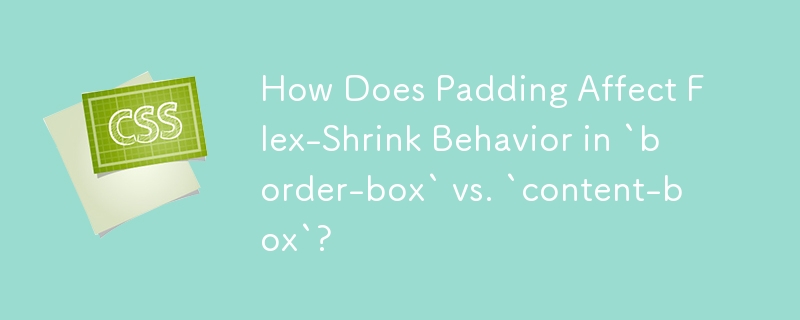 Web Front-end
Web Front-end
 CSS Tutorial
CSS Tutorial
 How Does Padding Affect Flex-Shrink Behavior in `border-box` vs. `content-box`?
How Does Padding Affect Flex-Shrink Behavior in `border-box` vs. `content-box`?
How Does Padding Affect Flex-Shrink Behavior in `border-box` vs. `content-box`?

Flex-shrink Factor in Padding and Border-Box
The flex-shrink factor is used to determine how much an element will shrink when there is negative space in the flex container. When padding is applied to an element, the inner flex basis is affected, depending on the value of box-sizing.
- Content-box: The inner flex basis includes only the content, so padding does not affect the available space for shrinkage.
- Border-box: The inner flex basis includes both content and padding, so padding reduces the available space for shrinkage.
To calculate the scaled flex shrink factor for each item, multiply its inner flex basis by its flex shrink factor. Then, find the ratio of each item's scaled flex shrink factor to the sum of all scaled flex shrink factors. Finally, set the item's target size to its flex basis minus a fraction of the negative space proportional to the ratio.
With no padding, the calculation is straightforward:
Inner Width = Inner Flex Basis + Ratio * Remaining Free Space
With padding, the available space is reduced, so the remaining free space changes.
In the case of border-box, the specified flex bases are the outer bases (including padding). The inner bases are calculated by subtracting padding widths. The sum of the scaled flex shrink factors remains unchanged, but the ratio and target size are adjusted:
Inner Width = (Outer Flex Basis - Padding) + Ratio * Remaining Free Space
Example:
Consider a flex container with three items, each with a flex-shrink factor of 2:
- Item 1: Flex basis = 300px, padding = 0px
- Item 2: Flex basis = 200px, padding = 0px
- Item 3: Flex basis = 100px, padding = 0px
Scenario 1 (No Padding):
- Remaining free space = -200px
- Scaled flex shrink factors: 600, 200, 200
- Sum of scaled flex shrink factors = 1000
- Ratios: 0.6, 0.2, 0.2
- Inner widths: 180px, 160px, 60px
Scenario 2 (Padding = 10px):
- Remaining free space = -260px
- Scaled flex shrink factors: 560, 200, 160
- Sum of scaled flex shrink factors = 920
- Ratios: 0.61, 0.22, 0.17
- Inner widths: 144px, 148px, 48px
Scenario 3 (Border-Box):
- Remaining free space = -200px
- Scaled flex shrink factors: 636, 240, 176
- Sum of scaled flex shrink factors = 1052
- Ratios: 0.6, 0.23, 0.17
- Inner widths: 176px, 160px, 64px
The above is the detailed content of How Does Padding Affect Flex-Shrink Behavior in `border-box` vs. `content-box`?. For more information, please follow other related articles on the PHP Chinese website!

Hot AI Tools

Undresser.AI Undress
AI-powered app for creating realistic nude photos

AI Clothes Remover
Online AI tool for removing clothes from photos.

Undress AI Tool
Undress images for free

Clothoff.io
AI clothes remover

Video Face Swap
Swap faces in any video effortlessly with our completely free AI face swap tool!

Hot Article

Hot Tools

Notepad++7.3.1
Easy-to-use and free code editor

SublimeText3 Chinese version
Chinese version, very easy to use

Zend Studio 13.0.1
Powerful PHP integrated development environment

Dreamweaver CS6
Visual web development tools

SublimeText3 Mac version
God-level code editing software (SublimeText3)

Hot Topics
 Vue 3
Apr 02, 2025 pm 06:32 PM
Vue 3
Apr 02, 2025 pm 06:32 PM
It's out! Congrats to the Vue team for getting it done, I know it was a massive effort and a long time coming. All new docs, as well.
 Building an Ethereum app using Redwood.js and Fauna
Mar 28, 2025 am 09:18 AM
Building an Ethereum app using Redwood.js and Fauna
Mar 28, 2025 am 09:18 AM
With the recent climb of Bitcoin’s price over 20k $USD, and to it recently breaking 30k, I thought it’s worth taking a deep dive back into creating Ethereum
 Can you get valid CSS property values from the browser?
Apr 02, 2025 pm 06:17 PM
Can you get valid CSS property values from the browser?
Apr 02, 2025 pm 06:17 PM
I had someone write in with this very legit question. Lea just blogged about how you can get valid CSS properties themselves from the browser. That's like this.
 Stacked Cards with Sticky Positioning and a Dash of Sass
Apr 03, 2025 am 10:30 AM
Stacked Cards with Sticky Positioning and a Dash of Sass
Apr 03, 2025 am 10:30 AM
The other day, I spotted this particularly lovely bit from Corey Ginnivan’s website where a collection of cards stack on top of one another as you scroll.
 A bit on ci/cd
Apr 02, 2025 pm 06:21 PM
A bit on ci/cd
Apr 02, 2025 pm 06:21 PM
I'd say "website" fits better than "mobile app" but I like this framing from Max Lynch:
 Comparing Browsers for Responsive Design
Apr 02, 2025 pm 06:25 PM
Comparing Browsers for Responsive Design
Apr 02, 2025 pm 06:25 PM
There are a number of these desktop apps where the goal is showing your site at different dimensions all at the same time. So you can, for example, be writing
 Using Markdown and Localization in the WordPress Block Editor
Apr 02, 2025 am 04:27 AM
Using Markdown and Localization in the WordPress Block Editor
Apr 02, 2025 am 04:27 AM
If we need to show documentation to the user directly in the WordPress editor, what is the best way to do it?
 Why are the purple slashed areas in the Flex layout mistakenly considered 'overflow space'?
Apr 05, 2025 pm 05:51 PM
Why are the purple slashed areas in the Flex layout mistakenly considered 'overflow space'?
Apr 05, 2025 pm 05:51 PM
Questions about purple slash areas in Flex layouts When using Flex layouts, you may encounter some confusing phenomena, such as in the developer tools (d...





